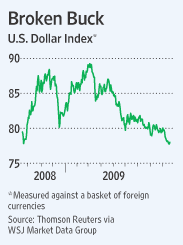October 1st 2009
Dollar Carry Trade in “Eight Inning”
The performance of virtually every currency against the Dollar (with the lone, major exception being the British Pound) in the last quarter has been downright impressive. Put another way, the performance of the Dollar has been downright pathetic.

The Dollar’s under-performance is no mystery. While some critics have pointed to long-term weaknesses such as the trade and budget deficits, most of the current impetus continues to come from low US interest rates. As I have reported recently, US short-term rates (based on the 3-month LIBOR rate for Dollars) is already the lowest in the world, and is still moving lower.
As a result, investors have been able to comfortably borrow in Dollars, and invest the proceeds in (comparatively) risky assets, predominantly outside the US. “Low rates have weighed on the dollar as equities have rallied over the summer, leading risk-based traders to buy the higher-yielding euro and commodity-based currencies, such as the Australian dollar, over the safe-haven greenback,” summarized the WSJ.
For most of the last 20 years, such a carry trade strategy would have been most profitable if funded using Yen or Swiss Francs. Since the stock market rally in May, however, buying a basket of emerging market currencies using the Dollar as a funding currency would yield the highest returns, as much as 10% higher than if the same trade had been funded using Yen. Moreover, the Sharpe-ration for such a trade (which seeks to measure the invariability of returns) is the highest when shorting the Dollar, implying that not only is this strategy lucrative, but also comparatively stable.
For a few reasons, however, analysts are beginning to wonder whether the Dollar carry trade has (temporarily) run its course. Technical indicators, for example, suggest that the Dollar may have appreciated too far, too fast. “The U.S. currency rose…after the 14-day relative strength index on the euro- dollar exchange rate climbed yesterday to 74, the highest level since March. A reading of 70 may indicate a rally is approaching an extreme and a reversal is imminent.” Stochastic indicators yield similar interpretations. “Traders have placed an unusually high volume of bearish bets against the U.S. dollar in recent weeks and may want to lock in profits by reversing those trades.” Besides, anecdotal evidence implies that anti-Dollar sentiment may be reaching irrational levels, as every other investors now seems to be betting against the Dollar.
From a rates perspective, the Dollar carry trade may soon become less viable. The markets (as reflected in futures prices) largely expect the Fed to be the first major Central Bank to hike rates, perhaps as soon as 2010 Q2. The ECB, by comparison, is not expected to hike until at least two quarters later, while the Bank of Japan is nowhere even near close to tightening monetary policy. The Fed is also beginning to contemplate possible exit strategies for its quantitative easing programs, which suggests that it is becoming concerned about inflation. One analyst connects this to a decline in the carry trade: “There might be a little bit of nervousness going into the FOMC if they start signaling any potential unwind of quantitative easing. There is a bit of risk over the next couple of days of the dollar starting to recover a little bit of ground.”
Finally, there are concerns that another crisis could trigger a pickup in risk aversion, in which case investors would likely return to the Dollar en masse. Recall that in 2007, when the Japanese Yen carry trade was in vogue, the main concern was volatility. Traders weren’t ever afraid that the BOJ would hike rates. Rather, they feared that some kind of event would inject uncertainty into the markets, making their returns (via the Yen) erratic. If investors suddenly got nervous about the ongoing stock markets rally, then the Dollar could conceivably become more volatile, which would make carry traders think twice.
At the same time, emerging market currencies will continue to offer much higher interest rates than the Dollar. While the Dollar, then, could conceivably become more attractive relative to the Yen, for example, it will remain extremely unattractive compared to high-yielding currencies. The yield differentials are currently so enormous that even if the Fed raised rates tomorrow, it would still be immensely profitable to short the Dollar relative to the Brazilian Real or South African Rand. While the Dollar slump may be reaching an endpoint, a Dollar rally will not necessarily follow. Brace yourself for sideways trading.




October 2nd, 2009 at 8:34 pm
Hmmm… I feel indifferent here. I’ve been buying into the dollar since the 16th with a short position in GBPUSD. I suspect it will fall well down to 1.5550 before any sort of trend reversal will take place.
October 3rd, 2009 at 2:44 am
[…] Adam Kritzer discusses the dollar’s weakness and focuses on the low interest rates. He also writes about the prospects for a renewed strengthening of the greenback. […]